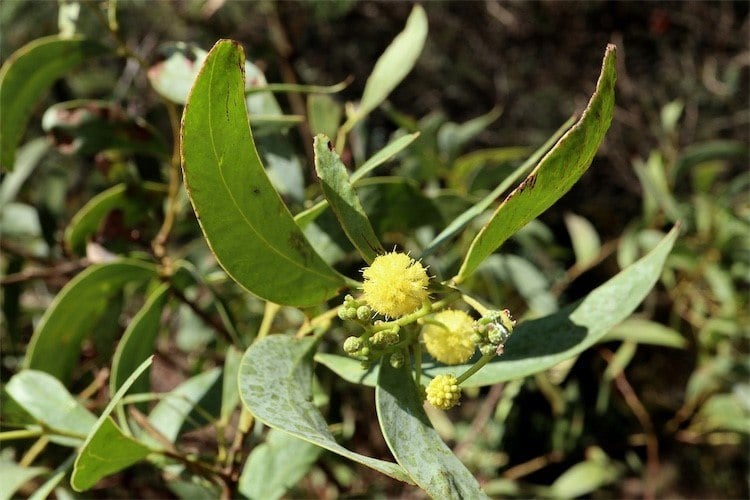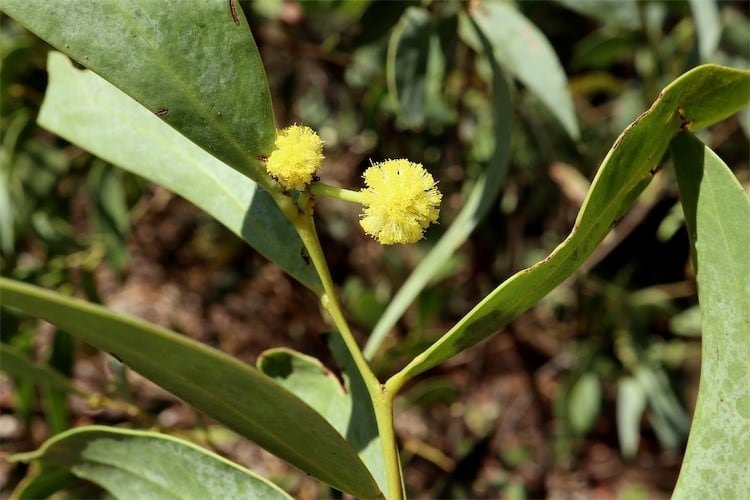Acacia confluens Maiden & Blakely
WATTLE
Acacias of Australia
Common Name
Wyrilda
Family
Fabaceae
Distribution
Endemic in the northern Flinders Ra. from Mt Lyndhurst and Arkaroola N to near Moolawatana, S.A.
Description
Shrub 2–3 m high; crown spreading and umbrella-like. Branchlets glabrous. Phyllodes narrowly elliptic, falcately recurved, 6–14 cm long, 5–12 mm wide, to 25 mm wide at base of branches, acuminate, glabrous, ±scurfy with age, 1-nerved per face; lateral nerves few and obscure; glands sometimes 2, with the lowermost normally 2–6 mm above pulvinus. Inflorescences usually racemose; raceme axes mostly 2–4 cm long, glabrous; peduncles usually 6–15 mm long, to 25 mm in fruit, glabrous; heads globular, 8 mm diam. at anthesis, densely 40–60-flowered, pale yellow. Flowers 5-merous; sepals united almost to apex. Pods rounded on opposite sides over alternate seeds, to 25 cm long, 12–17 mm wide, thickly coriaceous to subwoody, glabrous. Seeds longitudinal, broadly elliptic, 6.5–7.5 mm long, slightly shiny, black; funicle encircling seed in a double fold, thick, red-brown to black; aril clavate.
Habitat
Grows mainly in shallow calcareous loam, on steep stony hillsides and in gullies amongst outcropping quartzite, in tall shrubland.
Specimens
S.A.: near Arkaroola Bore, c. 95 km ENE of Leigh Creek, 14 Dec. 1968, B.Evans s.n. (AD, PERTH); Mt Gee near Arkaroola, R.H.Kuchel 3185 (AD, MO, PERTH).
Notes
A member of the widespread ‘Acacia microbotrya group’ characterised by its markedly acuminate phyllodes and thickly textured, large pods. The carpological characters serve to distinguish A. confluens from the widespread A. jennerae (which has similarly acuminate phyllodes) and from the more southerly distributed A. retinodes. J.M.Black, Fl. S. Australia 2nd edn, 2: 411 (1948), treated A. confluens as conspecific with A. retinodes.
A variant from Mt Painter, near Arkaroola, S.A., is unusual in having single, axillary peduncles 1–2.5 cm long (e.g. 9 June 1972, B.Maloney, AD, K, MEL, NSW).
FOA Reference
Data derived from Flora of Australia Volumes 11A (2001), 11B (2001) and 12 (1998), products of ABRS, ©Commonwealth of Australia
Author
B.R.Maslin
This identification key and fact sheets are available as a mobile application:
URL: https://apps.lucidcentral.org/wattle/
© Copyright 2018. All rights reserved.










